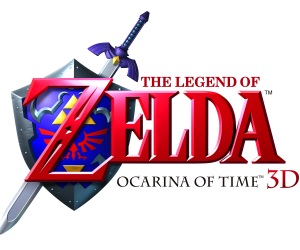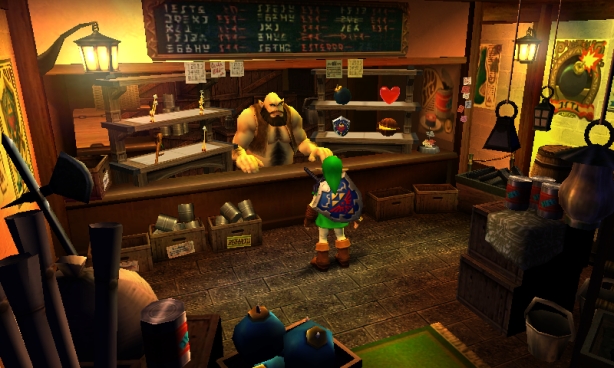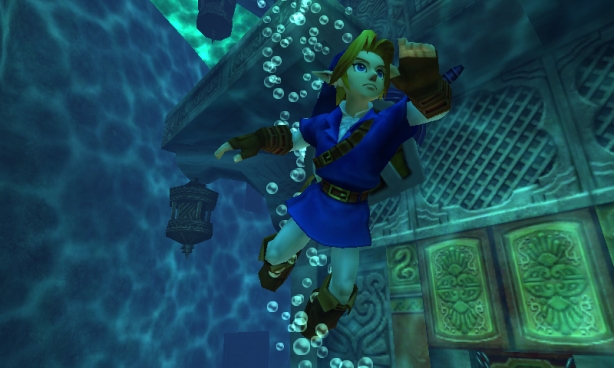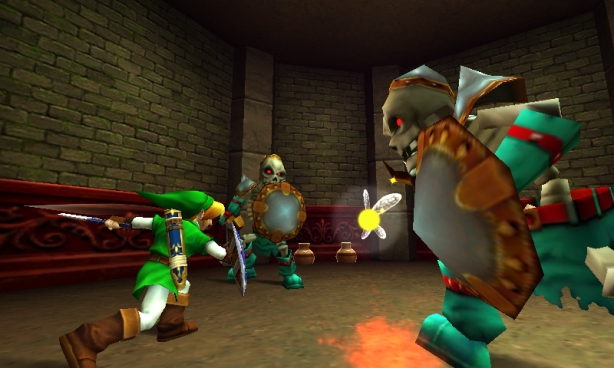The Legend of Zelda: Ocarina of Time 3D Review
 Game: The Legend of Zelda: Ocarina of Time 3D
Game: The Legend of Zelda: Ocarina of Time 3D
Developer: Nintendo
Publisher: Nintendo
Available on: Nintendo 3DS Only
When you cast your mind back, there are some classic gaming experiences that when dwelled upon, leave you wishing you could find a cosmically souped-up DeLorean to go back in time and get some of that magical first play feeling all over again. Sometimes, revisiting an old retro friend from consoles past can be disappointing, as the creaky old thing just isn’t as great as you remember. But disappointing and Nintendo are two words you seldom relate to one another.
Forgetting the clutch of cruddy efforts for the ill-fated CDi, The Legend Of Zelda has always been a games franchise that you can rely upon to do the business time and time again. Go back and have a crack at the first game, and even though it has been 25 years since we first gasped with excitement at the pimped-out gold NES cart, it still plays brilliantly. In the same way that blocks with question marks, mushrooms and stars are instantly synonymous with the Mario universe, when you think of Zelda you think green tunic, bow and arrow, fairy fountains, Hylian shield; all iconic, all introduced by Miyamoto and co in that 1986 classic.
The puzzle solving, dungeon-conquering, fantasy adventure gameplay was improved upon and revisited many times by Nintendo in the ensuing years, and save for The Adventures of Link sequel, which incorporated side scrolling platforming sections, the action was seen strictly from an overhead view, in 2D. It took the company 12 years to take the plunge and introduce a 3D Link adventure, however when they finally did, just before Christmas 1998, they blew us away in a manner not seen since they first added an extra dimension to our Italian plumbing exploits with Super Mario 64. The Legend of Zelda: Ocarina of Time was an action adventure par excellence, taking all of the classic elements from earlier games in the series and upping the stakes in every possible way. It was universally adored, garnering perfect scores from critics, and is still considered to be among the finest games ever created. Although it is still early doors, the Nintendo 3DS could really do with a grade-A release to generate a bit of interest in the console. Could this highly anticipated release be what it is crying out for? Is it possible to improve upon perfection?
STORY: First things first, the developers of this remake have not messed around with the storyline side of things. Ocarina of Time follows the series protagonist Link in another adventure in the fictional land of Hyrule. If you have played any of the previous games in the series, the bones of the plot are pretty standard stuff. Link is entrusted with the task of going toe-to-toe with a really bad dude intent on conquering the land, but this quest to be first to the legendary Triforce is given extra weight here by the introduction of superior time travelling elements that flip the action between two different periods, and the outstanding use of music. Musical instruments are a theme common to the series but here they are implemented with stunning effect as you learn memorable ditties for Link’s Ocarina that are used in order to progress.

Transferring the action to 3D also helps to become more immersed in the story. You will never forget your first encounter with the evil baddie Ganondorf, and you will become vaguelly emotionally attached to a talking tree stump and various other crazy monstrosities. You may even feel you are one cosplay outfit away from a genuine shot at Princess Zelda yourself. Sure, the tale being told here has been told many times before, but the familiarity of it all is like a loving embrace. For the umpteen hours you spend there, you almost become part of the Hylian universe.
GRAPHICS: The original title featured graphics that were outstanding for the time, but it is fair to say that returning to the original does show it up somewhat, with blocky characters and some jerky scrolling. The power of the 3DS is used to stunning effect to completely remodel Hyrule and everything in it, all in glorious stereoscopic 3D. Everything is improved dramatically, with bolder colours. The backdrops are now in proper 3D, and the characters are considerably more emotive than before with plenty more detail. Walking out onto the stunning Hyrule Field for the first time is incredible, even if you have played the game before; the depth of the 3DS top screen make the vivid sunsets and views of the many varied environments even more awesome than you could imagine. Fairies, orbs of light, and rays of sunshine float across the screen in moments of calm and quiet, whilst being plunged into combat the many enemy denizens you encounter look better and more fearsome than ever, particularly the mind-blowingly huge bosses you come across to top off each of the dungeons.
If that wasn’t enough, holding down the shoulder button and moving the console around allows you to scan the landscape using the baffling inner workings of the 3DS. Even with the 3D slider turned off, Ocarina 3D looks superb, maybe even a tad smoother in the framerate department. Mark this down as a Goron-sized success in the visuals department.
SOUND: There is a reason that the music of Zelda is so universally adored. That is because the series features some of the most memorable, fondly regarded tunes in videogame history. The man responsible is Koji Kondo, a wonderful gentleman who has been responsible for composing the majority of the company’s most iconic soundtracks over the years. If you have ever been in the Mushroom Kingdom, had a fracas with the Andross, or indeed swung the wieldy Master Sword, you would have done it whilst listening to one of Kondo-san’s sterling compositions.

Ocarina of Time has an incredibly array of sonics, on several different levels. Firstly you have the unforgettable tunes that play in each area. The bombast of the Hyrule Field theme creates an epic feel as you step outside your woodland village for the first time. The playful, annoyingly upbeat tune that pings along when you are in the tricky Lost Woods suits the action magnificently. A visit to the ranch gives us a wonderful frontier western-style backing, and the dungeons are given grand, echoing compositions that create a terrific sense of atmosphere.
The music changes to match the time of day, or the situation you are in. Nightime sees the music completely stop, whilst being confronted with an enemy gives you a malevolent, urgent tune that will only stop once the beastie you are facing has been destroyed. There are motifs that relate to different characters and places (this correspondent nearly cried when Sheik’s Theme was reintroduced to him after a 10 year hiatus), and of course the classic fanfares that are played when you discover a secret, open a treasure chest or discover a new item.
There is no proper speech, apart from a bit of “Hey!” and “Listen!” from your guiding fairy, Navi, and various yelps and grunts from Link and a handful of foes. But the sound effects are excellent, never irritating, and add to the action. Recognising certain sounds is also essential to the gameplay, for example the Gold Skulltula spider collectables make a recognisable noise when one is nearby, and certain walls will reverberate with a different noise when you strike them with Link’s sword, indicating secret paths and rooms. There is even a sonic addition to the 3DS version! The Stone Of Agony (an item in the original game that allowed you, via the N64’s Rumble Pak add-on, to be alerted to hidden items and secrets) is replaced by the Shard Of Agony, which achieves the same but with sound cues.
GAMEPLAY: As a remake of a game deemed to be near-untouchable in terms of gameplay, Grezzo did not have much room for manoeuvre, and it is pleasing to report that the classic adventure remains as brilliant, as enchanting, and as logically designed as it ever was. For those very lucky uninitiated explorers, the game is a 3D adventure that sees you explore the overworld, on foot, and later on your trusty steed Epona, interacting with non-playing characters, uncovering the nuances of the plot piece by piece. The aim is to enter one of the many differently themed dungeons (Water, Fire, Desert, etc) where you will unlock a new item or weapon that Link will need to use in order to move to the next area, and defeat an end of level boss. Along the way there are puzzles to solve, which vary from dungeon to dungeon, and whilst they are often testing, they are crafted in such a manner that you seldom, if ever, become frustrated and unable to progress.

The 1998 original introduced a ground-breaking “lock on” targeting system, which allowed you to focus on your enemies and circumnavigate them during fights. This is retained here, using the L shoulder button of the console. While this does become uncomfortable during sustained use due to the positioning of the button in relation to the analogue stick used to control Link’s movements, in principle it works just as well as ever, particularly during the impressive boss battles, which are always designed with the targeting system in mind. The camera is excellent, and as well as the aforementioned ability to hold down the L button, you can also enter into first-person mode, or indeed change the viewing perspective of certain areas, via the touch screen. You can also use some of the weapons and items (such as the Hookshot and the bow & arrow) as a handy means of scanning your surroundings.
The touch screen is put to such good use that you could argue it actually improves the gameplay of the 1998 original. Whereas in times past you had to enter your inventory and maps by pausing the game with the start button, here your stock of items and gear (and a map of where you stand) are always handily placed on the bottom half of your clamshell. Of course, you can still pause it if you want to when juggling things about, but it just makes things more fluent and convenient to have it so easily at hand, particularly in the much derided Water Temple, which 13 years ago was a ball-aching exercise in stop-start inventory screen annoyance, given the frequency you are required to change Link’s boots. The touch screen freshens the game up a great deal. Your Ocarina, which is such a crucial element of the gameplay given the frequency of use, is also activated via the lower screen, and a menu showing exactly how to play each of the songs you have learned is an absolute boon. Best of all, it is not uncomfortable to play with the 3DS stylus tucked between your fingers behind the console, so you can whip it out when required.
Another feature exclusive to the 3DS remake is a useful hint system. First encountered in your Kokiri Village starting point, Ocarina 3D introduces Sheikah Stones, which allow you to view “video clips” that give you a premonition of the future. Basically, it is something you can rely on when you get stuck, and the stone shows you what to do next. Purists will baulk at this news, particularly those who had nothing but the fledgling internet and the disinterested staff of the Nintendo Hotline to rely on back in the day, however the Crunk Juice and N-Dubz obsessed youth of today need all the help they can get, so for that there is no need to get worked up about the mystical shamanic rock entering the fray, and ultimately, it is your choice whether you approach the Sheikah for advice.
The main quest is supplemented by a number of additional distractions that will draw you even deeper into the game. Mini-games, collectables, even hatching your own chickens, there is so much to see and do in Hyrule, and the urge to reveal new areas of the map and unlock new and exciting weapons and items will keep you hooked.

LONGEVITY: Defeating Ganondorf is no easy task, and even if you whizz through without bothering with the extra content, Ocarina is still going to devour many hours of your life. Factor into the equation the many other distractions, such as finding all of the hidden collectables, completing the mask-trading missions, finding and capturing ghosts, and uncovering the many, many secrets, and you will realise why so many people of a certain age didn’t leave the house much for the latter part of 1998.
Be prepared, then, to become similarly waylaid, only more so, as Ocarina 3D also includes the excellent Master Quest, which is a remix of the original game, if you will, that features mirrored and rearranged dungeons that are surprisingly tough to beat. It also has as a winsome unlockable Boss Rush mode, which sets you the task of running through all of the exciting boss encounters in sequence, a bit like those featured in entries in the Castlevania and Metal Gear Solid series. Apart from going down Majora’s Mask boulevard, there is little else Nintendo could have done to give you bang for your buck, right here. And yes, that was a direct hint that similar treatment is required for a sequel.
VERDICT: Sod the DeLorean, playing Ocarina of Time 3D feels so fresh that it is just like falling in love with the game for the first time all over again. There isn’t anything you can justifiably criticise this excellent remake for, particularly given that it actually improves on the original in so many ways. Even veterans of numerous Ocarina runthroughs will find themselves gripped without ever questioning why. It is just gaming gold, pure and simple.
This is the shot in the arm that the 3DS needs. The nostalgia will ensure that many fans will want to pick up this game and rediscover its magic again, but this is not an exercise in trotting out a clunky old classic. On the new Nintendo 3DS hardware it feels current and new, and is the best and most legitimate reason to consider purchasing the console.





